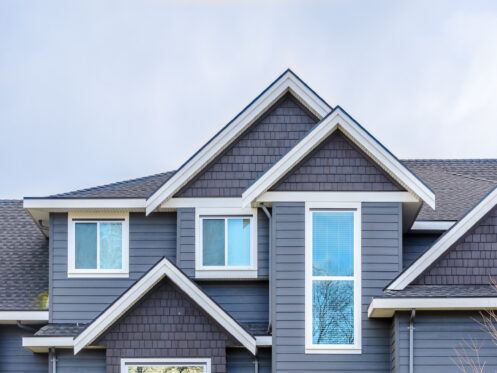In addition to serving as a covering, your home’s roof is an important component in stormwater management and water damage prevention. Water drains at different rates and flows in different directions. The pitch of a roof helps determine how well it drains rainfall.
What Is a Pitch on a Roof?
The pitch of a roof is its angle or slope. The ratio of the vertical rise to the horizontal run is a common way to express it, and it’s usually greater than 12 inches. For example, a 4:12 pitch roof would rise four inches for every 12 inches below it. Pitches on roofs can be very flat (1:12 or less) or very steep (12:12 or more). Architectural style, regional climate, building regulations and practical needs are some of the variables that influence the roof’s pitch.
How Roof Pitch Influences Water Runoff and Prevents Water Damage
As a result of its direct effect on water behavior on the roof surface, the pitch is an essential component of any home’s stormwater management system. The efficiency and velocity with which precipitation drains from a roof are highly dependent on its pitch.
Water is less likely to pool or infiltrate through roofing materials with steeper pitches because runoff is faster. In regions that experience heavy rainfall or frequent storms, this quick drainage plays a crucial role in preventing water from pooling and perhaps leading to leaks or structural damage.
Those with lower pitches may require stronger waterproofing because they store water for longer. Water runoff is not directly proportional to roof pitch; even a little adjustment in pitch can have a big impact on the way water acts on the roof.
Steep Roof Pitches: Advantages and Disadvantages
When it comes to managing stormwater, steep roof pitches (usually 6:12 or above) have a number of benefits. A major perk is the quick water shedding, which reduces the likelihood of leaks and flooding. Plus, debris, like leaves and branches, is less likely to collect on steep roofs, which means better drainage. And in addition to creating additional space for an attic or vaulted ceilings, steep slopes can improve your home’s visual appeal.
But there are difficulties associated with steep roofs as well. Repairs and inspections on these might be more risky and complicated, necessitating specialized tools and careful attention to detail. Materials and labor for a steep roof may be more expensive because of the larger surface area. Plus, steep roofs in windy regions may need greater reinforcing in the structure to withstand wind uplift forces.
Low-slope Roofs: Challenges and Solutions
One of the most difficult aspects of stormwater management is dealing with roofs that have a low pitch, defined as a 3:12 or lower. Leaks, material deterioration, and structural problems can result from water accumulating on these roofs if it’s not dealt with correctly. Nevertheless, because of their affordability and ability to maximize available interior space, low-slope roofs find widespread use in both commercial and residential settings.
There are a number of options available to address the difficulties of low-slope roofs. Improved waterproofing is one benefit of using built-up roofing (BUR) or single-ply membranes, both of which are specialty roofing materials developed for low slopes. The installation of a suitable drainage system, which should include tapered insulation to provide slope when necessary, is pivotal. Keeping the drains free and the roofing material in good condition by inspecting and maintaining them regularly is also important.
Impact of Roof Pitch on Gutter and Drainage Systems
Roof pitches have a significant impact on how well gutters and drainage systems perform. To manage the higher volume and faster flow of water runoff, steeper roofs typically necessitate wider gutters and more frequent discharges. Gutter placement on steep roofs is especially important for water collection and overflow prevention.
Roof drains and scuppers, which are part of an interior drainage system, are frequently preferable to conventional gutters for low-slope roofs. Proper water flow and obstruction prevention necessitate meticulous system design for these systems. No matter the angle of the roof, it’s critical to place and size the drainage components to ensure that they can manage the anticipated water flow without backing up or overflowing.
Choosing the Right Roofing Materials for Different Pitches
The roof’s pitch is a major factor in determining the best roofing material to use. Asphalt shingles, clay or concrete tiles, slate, metal panels, and any steep-slope roof with a pitch of 4:12 or above can support a variety of roofing materials. To rapidly drain water, these materials depend on overlapping installation procedures that are in sync with gravity.
Roofs with a low pitch (less than 4:12) require materials that can form a continuous waterproof membrane. Numerous options are available, including modified bitumen, built-up roofing (BUR), EPDM (rubber), TPO and PVC membranes. With their waterproof seals at penetrations and joints, these materials do an excellent job of enduring standing water.
Architectural Considerations for Roof Pitch in Storm-prone Areas
In regions that frequently experience hurricanes or heavy snowfall, the roof pitch is a crucial factor in the home’s resistance to inclement weather. Stormwater management and structural soundness are two of the many practical concerns that architects and designers must address.
Roofing with a moderately steep pitch (between 6:12 and 9:12 on the pitch scale) is frequently the best option in hurricane-prone regions because it allows for effective water shedding with less surface area accessible to the wind. Steeper pitches mitigate the danger of structural stress and ice dam formation in regions that receive high snowfall by preventing snow and ice buildup.
The Role of Roof Pitch in Sustainable Stormwater Management
To lessen their influence on the environment and increase their energy efficiency, sustainable roofs use a variety of eco-friendly materials and design techniques. Solar roofs incorporate photovoltaic panels to provide renewable energy while green roofs use vegetation for insulation and drainage management. When it comes to environmentally friendly roofing, the roof pitch is king.
To facilitate efficient stormwater management and reduce the risk of leaks, steeper pitches are generally preferred for rapid water shedding. They do a great job of providing solar panels with more optimal sunlight exposure. Low-slope roofs, on the other hand, are more likely to use reflective materials or green roof technology to reduce energy consumption and avoid water pooling. To maximize environmental benefits and long-term performance, it’s best to align the roof pitch with sustainable roofing materials and practices.
Effect of Roof Pitch on Roof Ventilation and Moisture Control
When it comes to controlling moisture in the roofing system and the attic, the pitch of the roof is a major factor because it determines the ventilation capacities. In general, natural ventilation works better when the pitch is steeper because a greater height difference between the eaves and the ridge creates stronger convection currents. Condensation and mold are less likely to form in an attic with this enhanced ventilation, which helps control the room’s temperature and humidity. A more complex ventilation system, including powered vents or specially designed low-profile vents, may be necessary to provide sufficient air circulation on low-slope roofs.
Now that you understand the important role of a roof pitch in stormwater management, it’s time to get a professional opinion. Here at Warren Thompson & Son Roofing & Siding, we help homeowners in Alpha, NJ with roofing repairs and replacements of all types. We also work on siding, gutters, and storm damage repair. Give us a call today to speak with an expert about how to make sure your roof’s pitch is at the right angle to facilitate effective stormwater management.

